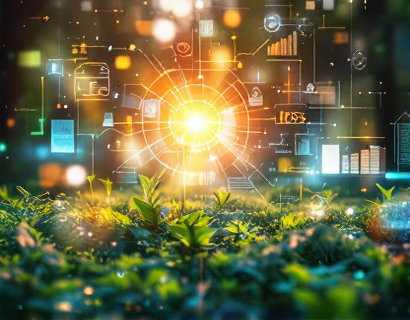Advanced Analytics for Sustainable Horticulture: Optimizing Resource Management and Enhancing Crop Yields with Data-Driven Insights
In recent years, the integration of advanced analytics in horticulture has emerged as a pivotal strategy for achieving sustainability and enhancing agricultural productivity. By leveraging sophisticated environmental analytics software, horticulturists and farmers can optimize resource management and significantly boost crop yields. This approach not only ensures higher economic returns but also promotes eco-friendly practices, contributing to a healthier planet. The application of data-driven insights in horticulture represents a transformative shift, enabling precise and efficient decision-making processes.
Understanding the Role of Advanced Analytics in Horticulture
Advanced analytics in horticulture involves the use of complex data analysis techniques to process and interpret large volumes of agricultural data. This data can originate from various sources, including soil sensors, weather stations, drones, and satellite imagery. The primary goal is to transform this data into actionable insights that can guide farmers and horticulturists in making informed decisions. By doing so, these professionals can optimize the use of water, fertilizers, and pesticides, thereby reducing waste and environmental impact.
The application of advanced analytics extends beyond resource optimization. It also plays a crucial role in enhancing crop yields. Through detailed analysis of historical and real-time data, farmers can identify patterns and trends that influence crop growth and productivity. For instance, by analyzing soil moisture levels, temperature, and light exposure, farmers can determine the optimal conditions for specific crops, leading to improved growth rates and higher yields.
Optimizing Resource Management
One of the most significant benefits of advanced analytics in horticulture is the optimization of resource management. Traditional farming methods often rely on fixed schedules and uniform application of resources, which can lead to inefficiencies and environmental degradation. Advanced analytics allows for a more precise and dynamic approach, where resources are allocated based on real-time data and specific needs of the crops.
For example, soil moisture sensors can provide continuous data on soil hydration levels. This data, when analyzed through advanced algorithms, can trigger irrigation systems only when necessary, preventing overwatering and conserving water resources. Similarly, nutrient sensors can monitor the levels of essential minerals in the soil, enabling farmers to apply fertilizers precisely where and when they are needed. This targeted approach not only reduces the amount of fertilizers used but also minimizes the risk of nutrient runoff, which can harm local water bodies.
Water management is a critical aspect of sustainable horticulture. Advanced analytics can help in predicting water requirements based on weather forecasts, soil type, and crop type. By integrating this predictive data with real-time monitoring, farmers can implement smart irrigation systems that adjust water usage dynamically. This ensures that crops receive the exact amount of water they need, reducing water waste and promoting sustainable water use.
Enhancing Crop Yields through Data-Driven Insights
Enhancing crop yields is a primary objective for horticulturists, and advanced analytics provides powerful tools to achieve this goal. By analyzing a wide range of data points, farmers can identify the factors that most significantly impact crop growth and productivity. This includes not only environmental conditions but also genetic traits of the crops, pest and disease pressures, and market demands.
One key area where data-driven insights can make a substantial difference is in crop planning. By analyzing historical yield data, climate patterns, and market trends, farmers can make informed decisions about which crops to plant and when. This strategic planning can lead to higher yields and better market outcomes. For instance, if data indicates that a particular crop performs exceptionally well in a specific season, farmers can allocate more resources to that crop, maximizing their returns.
Another critical aspect is the monitoring and management of plant health. Advanced analytics can integrate data from various sources, such as drone imagery, soil sensors, and weather data, to provide a comprehensive view of plant health. Machine learning algorithms can detect early signs of stress or disease, allowing farmers to take corrective actions promptly. This proactive approach can prevent significant yield losses and ensure that crops remain healthy throughout their growth cycle.
Precision agriculture, enabled by advanced analytics, allows for the application of inputs like water, fertilizers, and pesticides at the exact location and time they are needed. This precision not only optimizes resource use but also enhances crop yields. For example, variable rate technology (VRT) uses GPS and sensor data to apply inputs at varying rates across a field, based on the specific needs of different areas. This tailored approach ensures that each plant receives the optimal amount of resources, leading to uniform and high yields.
Promoting Sustainable Practices
The use of advanced analytics in horticulture is inherently aligned with sustainable practices. By optimizing resource use and reducing waste, these technologies help minimize the environmental footprint of agricultural activities. Sustainable practices are essential for ensuring the long-term viability of farming operations and preserving natural resources for future generations.
One of the most significant environmental benefits of advanced analytics is the reduction of chemical inputs. Precision application of fertilizers and pesticides, based on real-time data, can significantly decrease the amount of chemicals used. This not only reduces the risk of chemical runoff into water bodies but also minimizes the exposure of beneficial organisms to harmful substances. Additionally, by optimizing the use of these chemicals, farmers can reduce their costs and contribute to a healthier ecosystem.
Soil health is another critical area where advanced analytics promotes sustainability. Continuous monitoring of soil conditions through sensors can help maintain optimal soil health by preventing over-fertilization and erosion. Healthy soil is essential for sustainable agriculture, as it supports plant growth, retains water, and sequesters carbon. By using data to manage soil health, farmers can ensure that their land remains productive and resilient over time.
Energy efficiency is also a key consideration in sustainable horticulture. Advanced analytics can optimize the use of energy-intensive equipment, such as irrigation systems and greenhouses. By analyzing data on energy consumption and crop requirements, farmers can adjust their operations to use energy more efficiently. For example, smart greenhouse systems can adjust heating, cooling, and lighting based on real-time data, reducing energy waste and lowering operational costs.
Case Studies and Real-World Applications
Several case studies demonstrate the practical benefits of advanced analytics in horticulture. In one example, a large-scale vegetable farm implemented a data-driven irrigation system that used soil moisture sensors and weather forecasts to control water usage. The result was a 30% reduction in water consumption without compromising crop yields. This not only saved the farm significant amounts of water but also reduced operational costs.
Another case involves a fruit orchard that utilized drone imagery and machine learning to monitor tree health and detect early signs of disease. By identifying problem areas early, the orchard was able to treat only the affected trees, reducing the overall use of pesticides and maintaining high fruit quality. This approach led to a 20% increase in yield and a significant reduction in chemical inputs.
These examples highlight the tangible benefits of advanced analytics in horticulture. By providing precise and actionable insights, these technologies enable farmers to make informed decisions that enhance productivity while promoting sustainability.
Challenges and Future Directions
Despite the numerous benefits, the adoption of advanced analytics in horticulture faces several challenges. One major hurdle is the initial cost of implementing these technologies. Advanced sensors, data processing systems, and software can be expensive, particularly for small-scale farmers. However, the long-term savings and increased productivity often justify the investment.
Another challenge is the need for technical expertise. Farmers and horticulturists must have a certain level of proficiency in data analysis and interpretation to fully leverage the insights provided by advanced analytics. Training and education programs can help bridge this gap, equipping professionals with the necessary skills to use these tools effectively.
Looking ahead, the future of advanced analytics in horticulture is promising. The continued development of IoT devices, machine learning algorithms, and big data platforms will further enhance the capabilities of these systems. Integration with other technologies, such as artificial intelligence and robotics, will create even more sophisticated and efficient agricultural systems. As these technologies become more accessible and user-friendly, their adoption is likely to grow, driving greater sustainability and productivity in the horticulture industry.
In conclusion, advanced analytics is revolutionizing sustainable horticulture by optimizing resource management and enhancing crop yields through data-driven insights. By embracing these technologies, farmers and horticulturists can achieve higher productivity, reduce environmental impact, and contribute to a more sustainable future. The journey towards smarter and greener agriculture is just beginning, and the potential for positive change is immense.










































